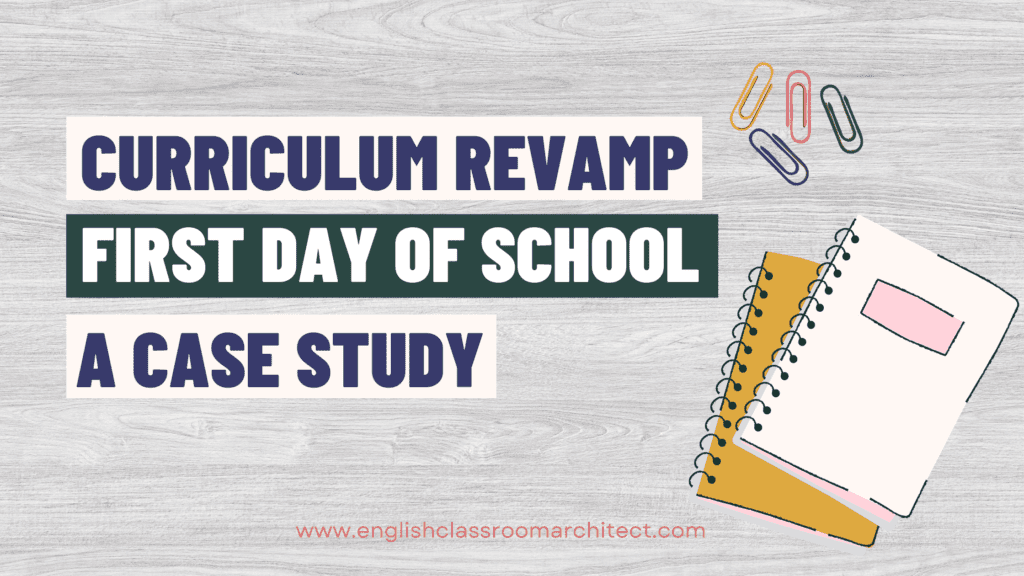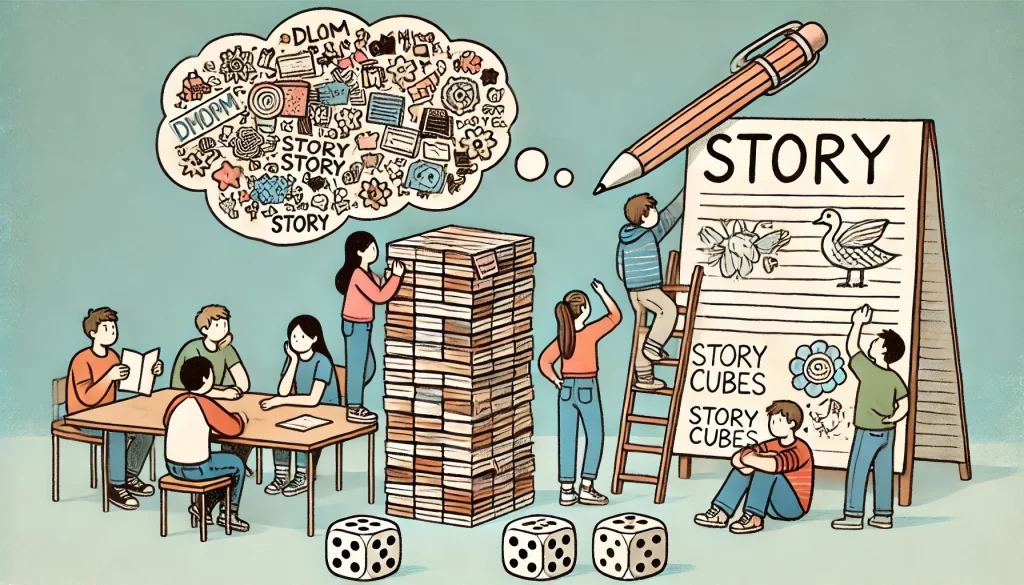The first day of school sets the tone for the entire year.
It’s a day filled with nervous energy, excitement, and the promise of new beginnings. Next year will be my 17th year of first days. Last year went pretty well, but I’m moving from 11th grade back to 10th grade this year, and I’m looking at everything with fresh eyes.
I’ve been working a lot on building a cohesive curriculum as part of my summer revamp process, and I wanted to create a first day that would truly encapsulate the spirit of our course, introduce key themes, and get students excited about the journey ahead. I also wanted to address some persistent challenges: increasing student engagement, reducing my own risk of burnout, and making classic literature more accessible through pop culture connections.
In this case study, I’ll take you through my process of reimagining the first day of school, from initial brainstorming to implementation and reflection. Whether you’re a new teacher looking for inspiration or a veteran educator considering a refresh, I hope you’ll find something that sparks your own planning in my experience.

Table of Contents
Why revamp the first day of school?
Before diving into the revamp process, let’s lay out why I felt adjustments were necessary. Here were my main motivations:
- Increasing student engagement: While my previous first-day activities weren’t bad, they weren’t particularly memorable either. I wanted to start the year with activities that would truly captivate my students’ attention and imagination.
- Better alignment with course themes: I realized that my first day wasn’t effectively previewing the key themes and skills we’d be exploring throughout the year. I wanted to give students a clearer roadmap of what to expect.
- Incorporating pop culture: As part of my ongoing effort to make classic literature more relatable, I wanted to start integrating pop culture references from day one.
- Setting expectations for critical thinking: Our class motto is “Question the Page,” but I wasn’t effectively introducing this concept on the first day.
- Reducing teacher burnout: By creating a more engaging and purposeful first day, I hoped to fuel my own enthusiasm for teaching and set a sustainable tone for the year.
My planning process for the first day of school
To address these goals, I went through a systematic process of reimagining our first day. Here’s a step-by-step breakdown of what I did:
Step 1: Identify goals for the new first day
I started by thinking through and articulating for myself what I wanted to achieve. My goals were to:
- Introduce key course themes and skills
- Set expectations for the level of engagement and critical thinking required
- Help students get to know each other and me
- Preview upcoming texts and projects
- Incorporate pop culture elements
- Introduce our class motto: “Question the Page”
Step 2: Brainstorm new activities
With these goals in mind, I began brainstorming potential activities. I used various resources and collaborative thinking (including some talks with my teenager and an AI brainstorming session) to generate ideas. Some initial thoughts included:
- A personality quiz related to literary characters
- Team-building activities with a literary twist
- Introduction to our independent reading program
- A creative writing exercise inspired by pop culture

Step 3: Align activities with course themes and pop culture elements
Next, I refined these ideas to ensure they aligned with our course themes and incorporated pop culture elements. This process led to the development of five core activities:
1. Literary Personality Trait Quiz: Last year I used an enneagram quiz which was so fun and interesting, but I just did not use this. Totally my fault. But, I really liked the idea of some kind of personality quiz. (I created two that you might be interested in – you can check out a personality quiz to find your teacher type and get anti-burnout strategies or find your pop culture teaching persona and I’ll send you some personalized lesson plan ideas). I drew on this idea to have students complete a quiz that connects them with personality traits of characters they will meet in our curriculum, setting the stage for deep character analysis.
2. “This or That” Literary Discussions: I have a set of resources in my TPT store designed for the first day of school that sets up conversations related to the literature in the form of “this or that” questions. I’ve done “this or that” conversations, but I didn’t actually do it as a first day of school activity…until now!
3. Story Tower Challenge: I love team building challenges, and while I don’t want my class to feel forced, I do think sometimes forcing an experience is really helpful in community building. In this activity, teams build the tallest tower possible while collaboratively crafting a story. So I’m using the traditional STEM skill icebreaker and adding a narrative creation element. Every two minutes a team member will come to the center and add a line to their team’s collaborative story using Story Cubes. The highest tower AND the most cohesive story wins.
4. “My Literary Life” Survey: In the past few years when I gave my standard reading survey more and more students seemed to take away that it was going to be okay not to read at all. So this year’s version is very similar to the reading habit and interest survey I do each year, but I am having students start or share the beginning of a to-read list and I’m using it to help students get to know the reading resources in the classroom, as well. I’m trying to set up the idea that this is not just a class, this is a time to work on building habits to live a literary lifestyle.
5. “Apply to My Class” Course Introduction: Students “apply” for class “jobs” like “Historical Context Researcher” or “Film Analysis Specialist,” immediately engaging them in the types of analysis and research they’ll be doing all year. This is a project that I have done for several years, but this year I revised the jobs to make them even more aligned to my curriculum.
Step 4: Create detailed lesson plan
With my activities chosen, I created a detailed lesson plan for the day. Here’s an overview:
1. Welcome and Introduction (5 minutes)
- Brief self-introduction
- Overview of the day’s activities and course themes
2. Literary Personality Trait Quiz (15 minutes)
- They’ll actually get started with this in the very beginning of the class period so they can avoid the awkward “talking to new people or waiting with nothing to do” if they want to
- Students complete the quiz and share results with a partner (at least they have something specific to share now)
3. “This or That” Literary Discussions (10 minutes)
- Present 5-6 scenarios that preview content of our course
- Students physically move to different sides of the room based on their choices
- Brief discussion after each scenario with a no spoiler explanation of how this relates to the course content
4. Story Tower Challenge (25 minutes)
- Explain rules and set up teams
- Teams build towers and craft stories (and laugh, hopefully)
- Share stories and measure towers
5. Break (5 minutes)
6. “My Literary Life” Survey (15 minutes)
- Students complete the survey
- Share one interesting thing about their reading life with a partner
7. Apply to the Class Introduction (10 minutes)
- Explain the “job application” concept
- Briefly describe each role
- Outline the application process and explain how to use templates on Canva (resume and cover letter)
8. Reflection and Wrap-up and Exit Ticket (5 minutes)
Step 5: Implementing the new plan
On the first day of school, I put this plan into action, emphasizing our class motto, “Question the Page,” encouraging students to think critically about every activity.
What I’m hoping for:
1. Increased engagement: Students actively participating from the moment they walked in. In the past a lot of my first day was “seat work” so I was mindful of having students engage in different ways and also move around the classroom.
2. Better understanding of course themes: By the end of the class, I’m hoping students have a clear idea of what to expect from the course. The literary personality quiz and “This or That” discussions, in particular, should spark interesting conversations about themes we’ll be exploring.
3. Stronger class community: The Story Tower Challenge and partner sharing activities should help students connect with each other right away.
Final thoughts for the first day of school
I didn’t plan the first day of school until I was mostly done with my revamp process. I’m glad I did. The process required me to think critically about my goals as a teacher and how to best set my students up for success.
This experience reinforced for me the importance of continually reflecting on and refining our teaching practices. Even something as seemingly straightforward as the first day of school can have a significant impact on the entire year.
For fellow educators considering a similar revamp, here are my key takeaways:
- Start with clear goals: Know what you want to achieve with your first day.
- Align activities with course themes: Make sure everything you do serves a purpose.
- Incorporate variety: Mix up activities to maintain engagement and address different learning styles.
- Don’t be afraid to try new things: Taking risks can lead to great rewards.
What does your first day of school look like? How might you reimagine it to better serve your students and your teaching goals? What are your plans for the first day? I’d love to hear what works for you and what you’re hoping to switch up! Share in the comments!
